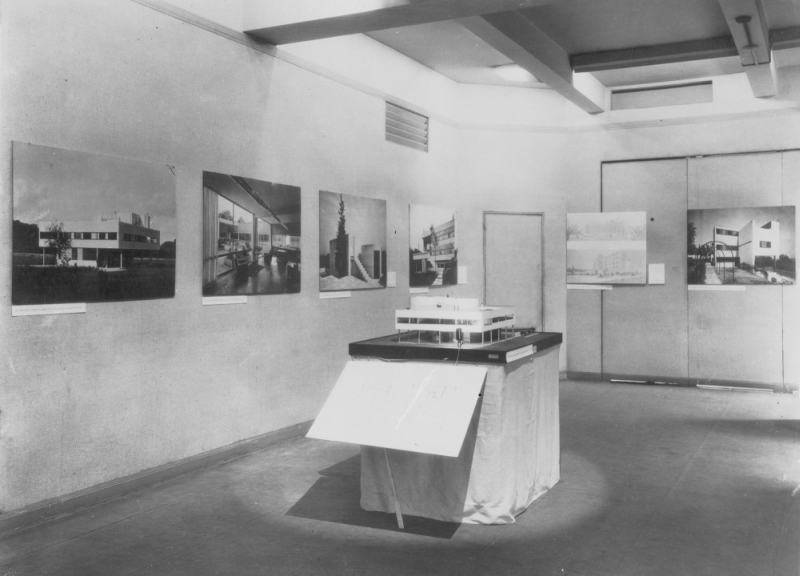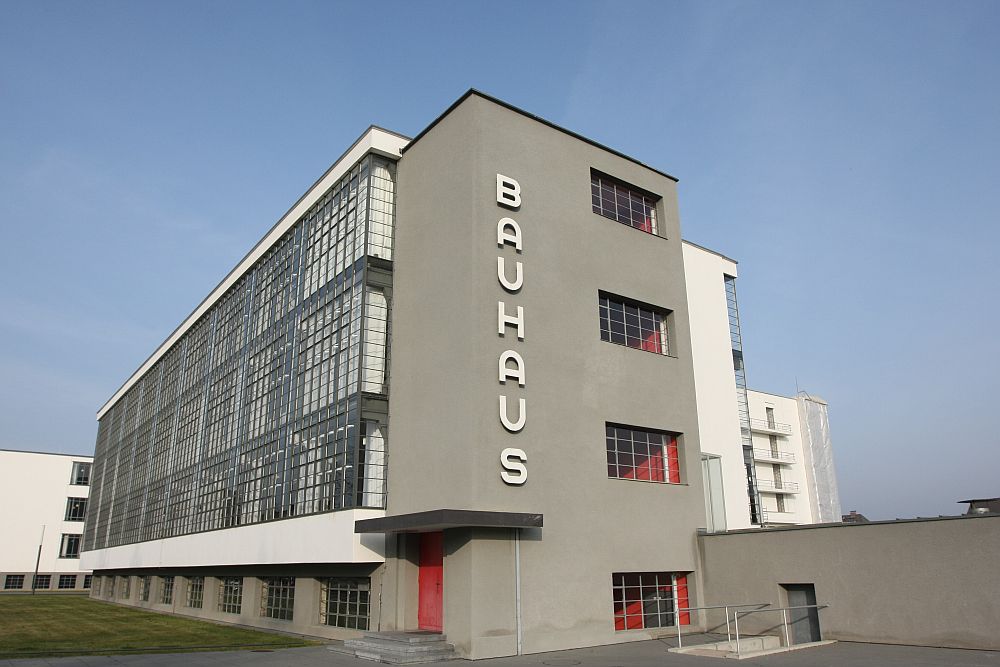(smow) blog Design Calendar: February 10th 1932 – Modern Architecture: International Exhibition opens at the MoMA New York
On the 10th February 1932 “Modern Architecture: International Exhibition” opened at the Museum of Modern Art in New York.
Much more than simply being the very first architecture exhibition staged in and by the MoMA, Modern Architecture represented the first exhibition ever specifically devoted to the new architecture of the day and perhaps most importantly bequeathed said architecture a name: The International Style.
If you will, with Modern Architecture, modern architecture had officially arrived.

A model of Villa Savoye by Le Corbusier as displayed at "Modern Architecture : International Exhibition" MoMa New York, 1932 (Photo: Museum of Modern Art New York)
Both the exhibition and the accompanying book, “The International Style: Architecture since 1922”, arose from a discussion in Paris in 1930 between the then MoMA director Alfred Barr, the architecture historian Henry-Russell Hitchcock and the architect Philip Johnson. Convinced that the new movements in architecture that had been visible since the early 1920s had crystallised, or at least were crystallising, into something important the trio undertook several trips through Europe in 1930 and 1931 to investigate the phenomenon at first hand.
The result was a conviction that “this contemporary style, which exists throughout the world, is unified and inclusive, not fragmentary and contradictory like so much of the production of the first generation of modern architects.”1 In their book Hitchcock and Johnson defined this unity and inclusivity by three characteristics: an emphasis on volume rather than mass, a regularity rather than a formal symmetry in the construction, and an “avoidance of applied decoration.”
As Falk Jaeger makes delightfully clear in his forward to the German edition of “The International Style”2 Hitchcock and Johnson were not the first to attempt to describe the changes taking place in the architecture of the period, nor were they first to publish a collection of images of important works of the period; however, they were the first to so categorically identify, and define, a unity. And to find a fitting, universally inclusive, name.
Presenting works by some 40 architects from fifteen nations through scale models and 1m x 2m photographs, Modern Architecture at the MoMA represented a veritable Who’s Who of the new style: Le Corbusier, Walter Gropius, Mies van der Rohe, Frank Lloyd Wright, J.J.P Oud, Richard Neutra, etc, etc, etc … A third section of the exhibition was given over to a discussion on issues in modern housing curated by the sociologist Lewis Mumford.
For the organisers a central aim of the exhibition was to introduce the general American public to the latest developments in modern architecture and to show that “modern architecture can achieve practical expression in every line of building – home, school, railroad station, apartment house, theatre, department store, civic building and church.”3
A particular motivation thereby appears to have been the position that “it was in America and by Americans that the true modern architecture of today was given the impetus which started it on the way to its present well-advanced stage of development”, an impetus that for all can be traced to the “revolutionary work of Frank Lloyd Wright”.4
Facts that the organisers felt were not properly understood by Americans.
The American public however didn’t seem particularly interested to learn.
Were such an exhibition to be staged today it would, without question, attract an eager and healthy flow of visitors. Modern Architecture didn’t. A mere 33,000 visitors found their way to the exhibition over its six week run, and in his forward to the 1995 edition of The International Style Philip Johnson notes, with a brutal honesty which is refreshing to find in context of exhibitions, “the general public couldn’t have cared less; Americans have never looked too much at architecture anyway. The newspaper and magazine media didn’t care either”5
However within the architecture profession the exhibition had a notable effect, for all during the two year tour of the United States it undertook following its tenure in New York. Owing to the age of the original publications we are largely dependent on secondary sources in order to follow the various strands of the debate; but, there certainly appears to have been a hard fought exchange of ideas amongst practising architects over both the value of the new architectural style, and the sense/correctness of giving said style a name.
And this discussion, coupled to the fortuitous timing of the show, was to provide the lasting legacy of the exhibition. Within a year of its opening the NSDAP had seized power in Germany and within half a decade the likes of Gropius, Mies van der Rohe, Marcel Breuer et al were in America, building and teaching.
Without the 1932 MoMA exhibition it is questionable if they would have had the necessary profile, and indeed clout, to have so effortlessly established themselves.
And had they not, what would remain today from the legacy of Bauhaus, Weissenhofsiedlung, et al….?
And how would downtown Chicago, St Louis or Manhattan look today?

Bauhaus Dessau by Walter Gropius, one of the European projects presented at "Modern Architecture : International Exhibition" MoMa New York, 1932
In celebrating the opening of Modern Architecture: International Exhibition and the publication of The International Style we don’t want to give the impression that we are celebrating the pigeonholing of architecture.
Far from it.
We fully appreciate that such pigeonholing, be it in music, literature, film or architecture, is only truly useful to and for historians, journalists and marketeers. And indeed that it is such pigeonholing that allows restaurants to label their cuisine as “fusion”. And feel a nauseating self-righteous justification in doing so.
We also fully appreciate that by defining the architecture of the period solely on physical characteristics and ignoring the economic, social and technological considerations that underscored many of the protagonists work, the “International Style” describes purely an elastic, essentially visual, “style” and not a precisely defined, conceptual “movement”.
And we accept the fact that the selection of projects for book and exhibition was less than scientific, and often made to ensure the trueness of the position rather than validity of the argument. Something that is particularly hard to ignore given Philip Johnson’s 1982 statement that “We decided to sweep everything under the rug to make an effect, and we certainly did”6
However, in giving the modern architecture of the day a platform, a name, a superficial simplicity, and, if you will, a freedom to differ while still conforming to an accessible umbrella term, the MoMA helped ensure the longevity of the ideals being expressed in the 1920s and 1930s and in the words of Philip Johnson “established architecture in the art world’s eyes. It made architecture a respectable endeavour”7
A sentence that perhaps more succinctly than most explains why architecture is treated the way it is today. And also explains why today architecture is so often misunderstood.
Especially by architects.
1. Henry Russell Hitchcock and Philip Johnson, “The International Style: Architecture since 1922”, Norton, New York, 1995
2. Henry Russell Hitchcock and Philip Johnson, “Der Internationale Stil 1932”, Friedr. Vieweg & Sohn Verlag, Braunschweig 1985
3. “Models assembled for opening of exhibit of modern architecture” Museum of Modern Art New York Press Release January 16th 1932 http://www.moma.org/pdfs/docs/press_archives/64/releases/MOMA_1932_0001_1932-01-16.pdf Accessed 09.02.2014
4. ibid
5. Henry Russell Hitchcock and Philip Johnson, “The International Style: Architecture since 1922”, Norton, New York, 1995
6. Barry Bergdoll, “International Style celebrate its 50th birthday,” Architectural Record, June 1982, pp. 45-47
7. Henry Russell Hitchcock and Philip Johnson, “The International Style: Architecture since 1922”, Norton, New York, 1995
General Bibliography:
Terence Riley, “The International Style: Exhibition 15 and the Museum of Modern Art”, Rizzoli, New York, 1992
Baharak Tabibi, “Exhibitions As The Medium Of Architectural Reproduction “Modern Architecture: International Exhibition” MA Thesis, The Graduate School of Natural and Applied Science of Middle East Technical University, Ankara, 2005
Tagged with: moma, museum of modern art, The International Style